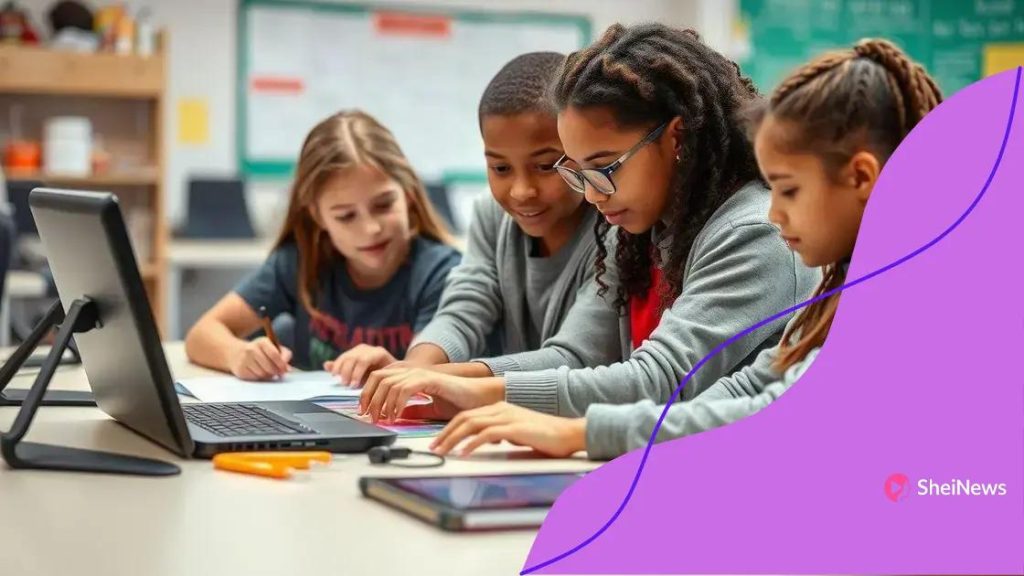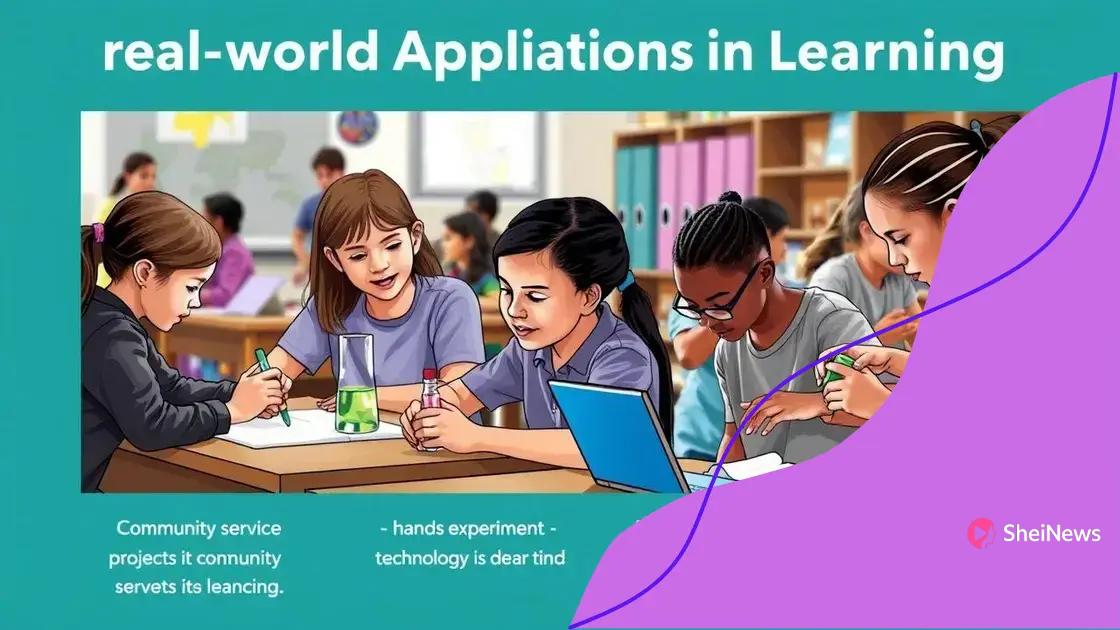Innovations in practical learning methods that change education

Anúncios
Innovations in practical learning methods enhance education by utilizing technology, promoting lifelong learning, and personalizing experiences to meet individual student needs, while addressing challenges such as resistance to change and resource limitations.
Innovations in practical learning methods are transforming how we approach education today. Have you ever wondered how new technologies and techniques can enhance your learning experience? Let’s dive into these exciting changes!
Anúncios
Understanding practical learning methods
Understanding practical learning methods is essential for fostering an environment where students can thrive. These methods enable learners to engage actively and apply knowledge in real-world scenarios. By focusing on hands-on experiences, students can better retain information and develop critical life skills.
Key Features of Practical Learning
Practical learning methods incorporate several key features that enhance the overall educational experience. These features not only aid comprehension but also inspire creativity and problem-solving abilities.
- Experiential Learning: Practical learning emphasizes learning through experience, allowing students to see firsthand how theories apply.
- Collaborative Projects: Group activities promote teamwork and communication, vital skills in today’s workforce.
- Real-world Applications: Applying knowledge to real-life situations bridges the gap between theory and practice.
Utilizing these methods can lead to significant improvements in student engagement and motivation. When learners actively participate, they take ownership of their education. This engagement can lead to higher retention rates and a deeper understanding of subjects.
Anúncios
Implementing Practical Learning in the Classroom
Educators can integrate practical learning methods across various subjects. Teachers can create assignments that require students to investigate, experiment, and solve problems rather than memorize information. For instance, in science classes, students can conduct experiments that illustrate concepts, while in history, they might engage in role-playing activities to understand different perspectives.
Additionally, technology can play a vital role in enhancing practical learning experiences. Online simulations and virtual labs allow students to experiment in a safe, controlled environment, making learning more accessible and engaging. By leveraging these tools, educators can foster a culture of exploration and curiosity.
Benefits of innovative approaches in education
The benefits of innovative approaches in education are numerous and impactful. These methods enhance learning experiences, foster creativity, and prepare students for the evolving job market. Embracing innovation in education can lead to more engaged and successful learners.
Enhanced Engagement
One major advantage of innovative educational strategies is their ability to capture student interest. Traditional learning methods often fall short in keeping students actively involved. However, innovative practices such as project-based learning and gamification make education interactive and fun.
- Increased motivation through interactive activities.
- Better retention of information through engaging lessons.
- Opportunities for personalized learning experiences.
When students find learning enjoyable and relevant, they are more likely to participate and succeed. This engagement also encourages collaboration among peers, further enhancing the learning process.
Development of Critical Skills
Innovative approaches equip students with essential skills for their future careers. By focusing on real-world applications, these methods help students develop critical thinking, problem-solving, and communication skills. For instance, through technology-based projects, students learn to navigate digital tools effectively.
Additionally, projects that encourage teamwork help students build interpersonal skills important for success in their personal and professional lives. These skills are invaluable as they prepare to enter a workforce that increasingly values adaptability and teamwork.
Furthermore, educational innovations foster a growth mindset. Students learn to embrace challenges, view failures as opportunities for growth, and develop resilience. These attributes are critical as they move through their educational journeys and into their careers, where adaptability is key.
Improved Learning Outcomes
Research shows that students in innovative learning environments often achieve better academic results. Traditional teaching methods can overlook various learning styles, but innovative practices address these differences. By incorporating diverse strategies, educators can reach all students.
As a result, enhanced learning outcomes lead to higher graduation rates and more students pursuing higher education. This trend benefits society by producing a well-educated populace equipped to tackle complex problems.
Real-world applications of practical learning

Real-world applications of practical learning offer students invaluable insights into how their education translates into everyday life. By connecting classroom concepts with practical experiences, learners can better understand the relevance of their studies.
Hands-on Experiences
One effective way to demonstrate practical learning is through hands-on experiences. For example, students can engage in community service projects that allow them to apply classroom skills. These activities foster a sense of social responsibility and teach collaboration.
- Environmental cleanup projects that highlight teamwork.
- Volunteer work in local shelters or organizations.
- Internships that provide insight into various careers.
Moreover, internships are excellent opportunities for students to practice skills in real work environments. These experiences can enhance their resumes and build professional networks while giving them a taste of their chosen fields.
Project-based Learning
Another popular method is project-based learning, where students work on real-world problems or challenges. This approach not only deepens their understanding of the subject matter but also encourages critical thinking and problem-solving.
For instance, students might create a marketing plan for a local business or design a community garden. Such projects require research, collaboration, and creativity, skills that are essential for future success.
Additionally, participating in competitions, like robotics contests or science fairs, fosters innovation and practical application of knowledge. These events challenge students to think critically and apply what they have learned in meaningful ways.
Technology Integration
Integrating technology into practical learning applications is becoming essential. Using tools such as virtual reality and simulations can enhance students’ understanding of complex concepts. For example, medical students can practice procedures in a simulated environment, while engineering students can design and test prototypes virtually.
This approach not only prepares students for future careers but also keeps them engaged in the learning process. By using technology in innovative ways, educators can create immersive learning experiences that resonate with today’s digitally native students.
Challenges in implementing new learning methods
Implementing new learning methods presents various challenges that educators must navigate. While innovative approaches can greatly enhance education, understanding these hurdles is essential for successful integration.
Resistance to Change
One significant challenge is resistance to change among educators and institutions. Many teachers are accustomed to traditional teaching methods, making it difficult to adopt new strategies. Some may feel overwhelmed by the idea of needing to learn new technologies or adapt their lesson plans.
- Fear of inadequate training for new teaching tools.
- Concerns about disruptions in established routines.
- Skepticism regarding the effectiveness of new methods.
Encouraging educators to embrace change requires ongoing professional development and support. Providing resources and training can help ease their transition into innovative practices.
Resource Limitations
Another barrier is the lack of resources available to implement new learning methods. Schools may struggle with limited budgets, which can restrict access to necessary tools and technologies. Without adequate resources, it can be challenging to carry out practical learning initiatives effectively.
For instance, schools might lack the funds to purchase new technology or materials needed for hands-on projects. This scarcity can hinder innovation and limit opportunities for students. Schools must find creative solutions to secure funding and collaborate with the community to enhance resources.
Curriculum Constraints
Existing curriculum constraints can also impede the adoption of practical learning methods. Many educational systems adhere to rigid assessment standards, which can discourage teachers from experimenting with new approaches. Teachers may feel pressured to cover a specific syllabus rather than explore innovative teaching techniques.
To address this, educational policymakers need to allow flexibility in curricula. By promoting an environment where experimentation is encouraged, educators can better integrate new learning methods into their teaching practices. Collaboration between teachers, administrators, and policymakers is essential in creating a more dynamic learning framework.
Future trends in educational innovation
Future trends in educational innovation promise exciting changes that will reshape how we teach and learn. As technology advances, education must adapt to prepare students for a rapidly evolving world.
Increased Use of Technology
One significant trend is the increased use of technology in the classroom. Tools like augmented reality (AR) and virtual reality (VR) allow students to experience immersive learning environments. For example, students can explore historical sites or conduct virtual science experiments without leaving their classrooms.
- Interactive simulations that make complex concepts easier to understand.
- Online collaborative tools that connect students across the globe.
- Personalized learning through adaptive learning technologies.
These technologies not only enhance engagement but also cater to various learning styles, making education more inclusive.
Focus on Lifelong Learning
The focus on lifelong learning is another emerging trend. As careers continue to evolve, people will need to adapt by continually updating their skills. Educational institutions will likely shift towards offering flexible learning options like online courses and micro-credentials.
These options will allow learners to acquire new skills at their own pace. This focus on ongoing education emphasizes the importance of equipping students with the tools they need to be adaptable in their careers.
Personalized Learning Experiences
Personalized learning experiences are becoming more common as educators recognize that each student has unique needs. This trend involves using data analytics to tailor education to individual learners. With this approach, teachers can identify students’ strengths and weaknesses, allowing them to customize lessons accordingly.
By providing tailored learning experiences, educators can help all students achieve their potential and foster a love for learning. The shift towards personalized education acknowledges that there is no one-size-fits-all method in teaching.
FAQ – Frequently Asked Questions about Innovations in Practical Learning Methods
What are practical learning methods?
Practical learning methods involve hands-on experiences that allow students to apply their knowledge in real-world situations, enhancing understanding and retention.
How can technology be integrated into practical learning?
Technology can be integrated through tools like virtual reality, simulations, and online collaborative platforms that make learning interactive and engaging.
What are the benefits of personalized learning experiences?
Personalized learning experiences cater to individual student needs, allowing them to progress at their own pace and improving overall engagement and comprehension.
What challenges might educators face when adopting new methods?
Challenges include resistance to change, limited resources, and rigid curricula that can make it difficult to implement innovative teaching strategies.





